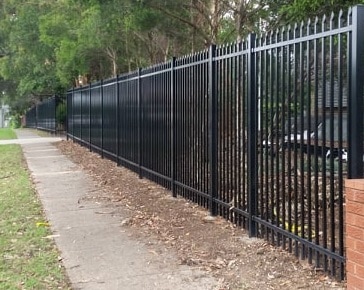Introduction
Timber fencing has actually constantly been a crowd favorite among homeowners and builders alike. But have you ever stopped to consider its ecological advantages? In an age where sustainability is at the leading edge of everybody's mind, selecting environment-friendly materials is more important than ever. This short article will dig deep into The Environmental Advantages of Choosing Timber Fencing, examining how this natural resource can contribute favorably to our planet, while also being a trendy choice for property and industrial properties.
When talking about fencing options, it's vital to know that lumber fences offer more than just aesthetic appeal. They offer a range of ecological benefits that make them an excellent choice for anyone aiming to improve their residential or commercial property sustainably. From boosted biodiversity to carbon sequestration, lumber fencing might surprise you with its green qualifications.
So, let's dive into the nitty-gritty of why selecting lumber fencing can be a favorable choice for both your property and the environment.
The Environmental Benefits of Choosing Lumber Fencing
Timber fencing stands apart not just for its charm but also for its ability to support sustainable practices. When we consider the ecological advantages, we find that wood fences contribute in multiple methods:
Sustainable Sourcing: Many lumber used in fencing originates from handled forests where trees are replanted after gathering. This practice ensures a constant supply of wood and minimizes deforestation.
Carbon Footprint Reduction: Timber acts as a carbon sink; it soaks up carbon dioxide from the atmosphere throughout its growth phase, helping to decrease greenhouse gases when utilized as a structure material.
Biodegradability: Unlike metal or plastic alternatives, wood is biodegradable. When your fence reaches the end of its life cycle, it can decay naturally without leaving harmful residues behind.
Habitat Creation: Lumber fences can serve as environments for numerous small creatures such as birds and pests, contributing positively to local biodiversity.
Energy Efficiency: Structure with wood normally needs less energy compared to manufacturing metal or artificial materials, therefore conserving energy resources throughout production.
Aesthetic Appeal: Timber's natural look mixes seamlessly with gardens and landscapes, promoting a connection in between developed structures and nature.
Now that we've covered some basic points about the environmental advantages of selecting wood fencing, let's explore extra elements in detail.
Understanding Various Types of Wood Fencing
Timber Paling Fences
Timber paling fences are one of the most popular choices among house owners due to their flexibility and cost-effectiveness. These fences are generally made from treated pine or hardwood like merbau or jarrah, offering durability while maintaining an environmentally friendly profile.
1. Features
- Cost-effective Easy installation Customizable heights
2. Benefits
- Excellent privacy Natural insulation properties
Picket Fences
For those seeking a traditional appearance, picket fences evoke beauty and fond memories while also using privacy and security without feeling too imposing.
1. Features
- Made from numerous kinds of timber Available in different styles (spaced vs close-set)
2. Benefits
- Enhances curb appeal Eco-friendly option
Colorbond Fences
While not made from wood, Colorbond fences are often compared due to their appeal in Australian homes. Nevertheless, they do not have lots of ecological advantages that lumber provides.
Comparison Table: Wood vs Colorbond Fences
|Function|Timber Fences|Colorbond Fences|| ---------------------------|---------------------|------------------------|| Sustainability|High|Low|| Biodegradability|Yes|No|| Aesthetic Appeal|Natural|Industrial|| Upkeep Requirements|Moderate|Low|
Aluminium Blade & Slat Fences
These contemporary options offer smooth designs however come with higher environmental costs due to producing processes involved in aluminium production compared to timber.
Fencing Alternatives by Fence Companies
When choosing your fencing choice through a trusted fence company or professionals like "Fence installers Melbourne" or "Fencing contractors Melbourne," consider going over environmentally friendly options such as:
- Wood Fence Company products Metal Fence Company options Automatic Gates
Retaining Walls & Their Environmental Impact
Retaining walls built from timber can support soil erosion while enhancing landscaping looks without harming the environment compared to concrete options.
Environmental Benefits over Metal Fencing Options
Though metal fences like tubular metal fences offer resilience and security functions, they do not provide the same level of sustainability as timber choices:
1. Energy Consumption
Manufacturing metals requires considerable energy which could otherwise be saved by going with wood alternatives.
2. End-of-Life Disposal
Metal recycling is possible but often https://parapetfencing.com.au/ includes energy-intensive processes compared to simply composting old wood materials.
FAQs About Lumber Fencing
Q1: The length of time does lumber fencing last?
A1: Depending on maintenance and wood type, excellent quality wood fencing can last anywhere between 10-25 years!
Q2: What types of wood are best for fencing?
A2: Dealt with pine is common for cost-effectiveness; nevertheless, hardwoods like merbau stick out for durability.
Q3: Do I require permits for installing brand-new fencing?
A3: Authorization requirements vary by area; always examine regulations within your regional council before installation!
Q4: Is timber fencing more costly than metal options?
A4: Preliminary costs may be lower with metal; however, long-lasting savings through sustainability make lumber an affordable option over time!

Q5: Can I paint my wooden fence?
A5: Definitely! Use weather-resistant paint created particularly for outside use to enhance longevity!
Q6: How do I preserve my wood fence?
A6: Regular cleaning followed by regular treatments (stains/sealers) will keep your fence looking great!
Conclusion
In summary, selecting lumber fencing presents many environmental benefits that surpass those provided by other materials like metal or artificial alternatives. Sustainable sourcing practices guarantee that our forests remain healthy while offering us with this eco-friendly resource; in addition, wood's distinct ability to sequester carbon makes it a much more appealing option amid growing concerns over climate change.
Whether you're working with recognized fence builders or engaging with regional "Fence installers Melbourne," understanding these benefits will allow you to make informed choices concerning your property's borders and general influence on our cherished planet.
So next time you're considering what type of fence fits you best-- think about going green! Embrace nature with open arms through The Ecological Advantages of Picking Lumber Fencing!